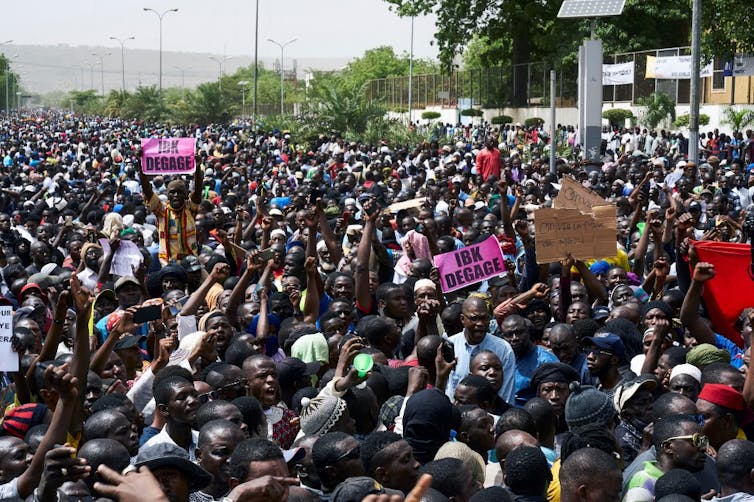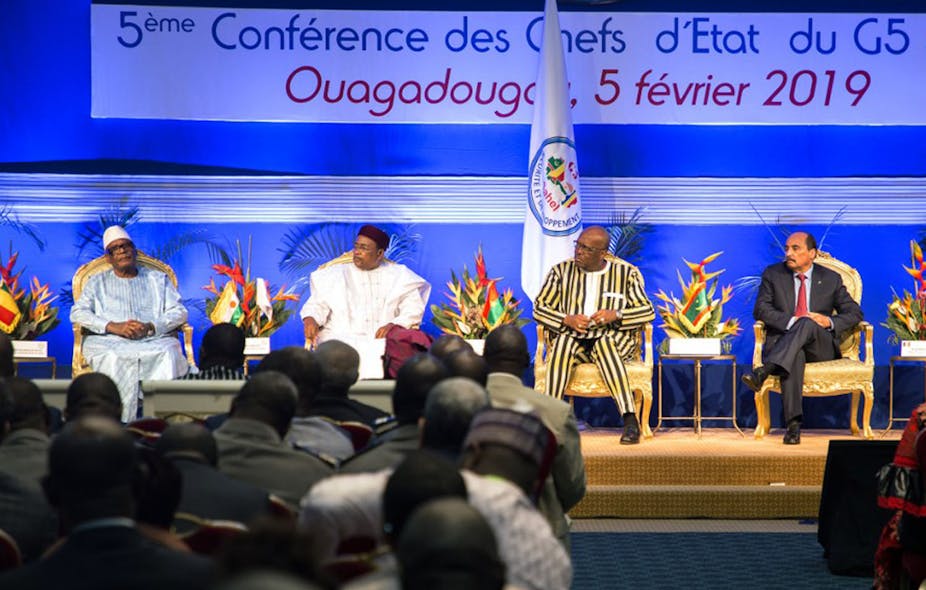Military solutions have clearly not been successful in the fight against terrorism in the Sahel. The lessons of America’s war in Afghanistan should have forced the international community to face facts: Kalashnikovs alone cannot defeat ideology nor solve the structural problems feeding the radicalisation of the young people who continue to join Boko Haram and the Islamic State in the Greater Sahara.
An example is the French Serval operation. This freed the northern cities in Mali from the hands of Jihadists in a spectacular operation, and ensured that Konna did not fall. Konna was a bulwark barring access to Bamako from determined assailants in January 2013.
But the current operation Barkhane is unable to banish terrorists from northern Mali, or from the outskirts of Niger, where the dangers of the Libyan conflict and Sahelo-Saharan instability converge.
Terrorist groups are prospering in the Sahel. And they are able to coordinate relatively substantial operations. Meanwhile, there is a myriad of international stakeholders, even within the European “family”, now seeking to play a major role. This even includes Germany which is no longer willing to take a back seat in affairs concerning the Sahel and West Africa.
Terrorism extends its tentacles
The terrorist front has expanded beyond its Malian epicentre to the region. The centre of Mali has become a zone of major tensions that have spilled out as far as the provinces of Sum and Udalan, in neighbouring Burkina Faso.
Under these conditions, many analysts are losing their bearings. They have only recently realised that the attacks in Ouagadougou, in August 2017 and March 2018, marked the end of West African exceptionalism. It has also become clear that the Grand-Bassam attack (Côte d'Ivoire) of March 2016 ushered in a new era, where predicting attacks has become meaningless.
We can no longer deny that military solutions are a necessary evil to stem growing threats and provide relief to countries under high security pressure. But past experience, and the day-to-day realities of populations in border areas, show that they are ultimately neither truly effective nor lasting.
On top of this, they inspire and feed into terrorist propaganda. Terrorist groups are masters at using symbols to send their messages people thrown into disarray by draconian security measures that kill local economies. Local people are also affected by the persistence of daily insecurity despite impressive military arsenals.
Unfortunately, Abul Walid Al-Sahraoui, the current mastermind of Islamic State in the Greater Sahara, chose the “right” approach following the end of the French Serval operation. He eschewed overarching strategies requiring complex organisation and logistics. Instead, he created increasing numbers of unstable zones, and capitalised on ethnic and community conflicts with a “simple”, “Islamic” veneer.
In his mind, this is a surefire way to provoke Western intervention, one of the best weapons in the armoury of a Jihadist propaganda. This cleverly plays on Western failures and eventual transgressions to feed the fires of frustration needed to recruit new fighters.
A new dilemma in the Sahel
The the G5 Sahel joint task force could have provided an alternative to a region dotted with bivouacs in French colours, or army bases topped with discreet American flags. But a lack of resources prevented it from becoming operational. This is despite numerous financial commitments that have yet to be honoured.
The security situation in the Sahel requires a paradigm shift from a strictly military solution. In addition, Germany appears to be engineering its arrival on the scene. It is doing this through the delicate balancing act of economic development.
On top of the worsening crisis in the Sahel, there are now widely diverging viewpoints regarding the conflict itself, with a rift between international approaches and local perceptions.
It is time to take internal responses and strategies seriously. And to change direction given the obvious failure of a military solution.
The terrorist strategy
Meanwhile, terrorist groups are redefining their strategy, feeding off and aggravating inter-community conflicts. This gives them two advantages. Firstly, it increases the number of unstable areas in the region. Secondly, it puts pressure on the international community, forcing it to resort to military intervention – a source of radicalisation and fodder for jihadist rhetoric.

Unfortunately, attacks like those at the start of the year in the village of Yirgou Fulbé, in Barsalogho, in central northern Burkina Faso will spread. Central Mali will once again become the focus of concerns, and neighbouring countries will certainly be impacted.
Burkina Faso has entered a cycle of violence sparked by inter-community conflicts which, initially, had nothing to do with religion but rather concerns over forest, crop-growing and grazing land.
Thanks to uncoordinated international strategies, terrorist groups are broadening their scope of action in the region. The unprecedented offensive in Burkina Faso is designed to breakdown the last barrier between the Sahel and the coast.
Today, conditions are ripe for the establishment of Islamic State in the Greater Sahara. This is especially true in Burkina Faso, a buffer region between coastal Africa and the Sahel, and, in particular, in areas like Gorom Gorom and Markoye, in Udalan province.
A new template is needed
The most surprising fact about the situation in the Sahel is that Western analysts remain stuck in the Jihadist paradigm. Their vocabulary is still dotted with terms like “Islamic groups,” “Jihadist cells,” and “radicalization” when the threat has long become hybridised, with a significant rise in inter-community conflict. Even in terrorist narratives, the religious rhetoric is increasingly giving way to the exacerbation of community tensions.
Gone is the era of ideological, religious-based discourse Jihadism. Nowadays, local communities only see “crime” and “banditry”.
It is clear to local populations, if not to “experts” and scholars of the region, that the Sahel has surreptitiously slipped into a new era, which for lack of any other name, hints at a post-jihadist world.
Translated from the French by Alice Heathwood for Fast ForWord.


